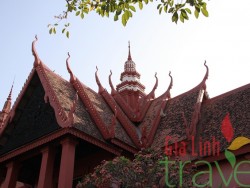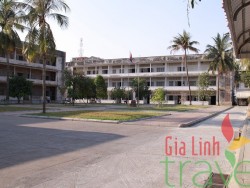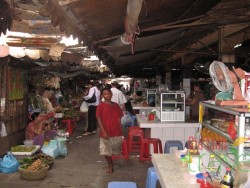National Museum
Phnom Penh
Toul Sleng Museum Russian Market Phnom Penh is the vibrant bustling capital of Cambodia. Situated at the confluence of three rivers, the mighty Mekong, the Bassac and the great Tonle Sap, what was once considered the ‘Gem’ of Indochina. The capital city still maintains considerable charm with plenty to see. It exudes a sort of provincial charm and tranquility with French colonial mansions and tree-lined boulevards amidst monumental Angkorian architecture. Phnom Penh is a veritable oasis compared to the modernity of other Asian capitals. A mixture of Asian exotica, the famous Cambodian hospitality awaits the visitors to the capital of the Kingdom of Cambodia. Here in the capital, are many interesting touristy sites. Beside the Royal Palace, the Silver Pagoda, the National Museum, the Toul Sleng Genocide Museum, the Choeng Ek Killing Fields and Wat Phnom, there are several market places selling carvings, paintings, silk, silver, gems and even antiques. Indeed, an ideal destination for a leisurely day tour. The whole area including the outskirts of Phnom Penh is about 376 square kilometers big. The city takes its name from the re-known Wat Phnom Daun Penh (nowadays: Wat Phnom or Hill Temple), which was built in 1373 to house five statues of Buddha on a man made hill 27 meters high. These five statues were floating down the Mekong in a Koki tree and an old wealthy widow named Daun Penh (Grandma Penh) saved them and set them up on this very hill for worshiping. Phnom Penh was also previously known as Krong Chaktomuk (Chaturmukha) meaning “City of Four Faces”. This name refers to the confluence where the Mekong, Bassac, and Tonle Sap rivers cross to form an “X” where the capital is situated. Phnom Penh is also the gateway to an exotic land – the world heritage site, the largest religious complex in the world, the temples of Angkor in the west, the beaches of the southern coast and the ethnic minorities of the North-eastern provinces. Ounalom Pagoda Wat Ounalom is another of Phnom Penh’s five original monasteries (1422). Until 1999, it housed the Institute Bouddhique and library. On the riverfront about 250 meters north of the National Museum, facing the Tonle Sap River near the Royal Palace, this pagoda serves as the headquarters for one of Cambodia’s most revered Buddhist patriarchs. Cheung Ek Killing Field Between 1975 and 1978, about 17,000 men, women, children and infants (including nine westerners), detained and tortured at S-21 prison (now Tuol Sleng Museum), were transported to the extermination to death to avoid wasting precious bullets. The remains of 8985 people, many of whom were bound and blindfolded, were exhumed in 1980 from mass graves in this one-time long an orchard; 43 of the 129 communal graves here have been left untouched. Fragment of Human bone and bits of cloth are scattered around the disinterred pits. Over 8000 skulls, arranged by sex, are visible behind the clear glass panels of the Memoral Stupa, which was erected in 1988. The Killing Fields of Choeung Ek are 15 km from Central Phnom Penh. The site is 8.5 km from the bridge near 271 St. A memorial ceremony is held annually at Choeung Ek on 9 May. Independence Monument An Angkorian style tower, the inimitable place in the whole city, located in the heart of the capital. It was built in 1958 to Sybilles Cambodian Independence Day after winning back their independence from the French protectorate on the 9th of November 1953. The monument attracts many tourists for its peculiar looking but unique style distinguishes it from all the buildings in the city. It is also used as a memorial place dedicated to the Cambodian’s patriot who died for the country. National Museum The NATIONAL MUSEUM has a good collection of Khmer sculptures dating from the pre-Angkor period (4th century) to post-Ankgor period (14th century). The museum, built of red bricks by the French in 1917 in a pseudo-Khmer style, is built around a courtyard. A stone’s throw away from the Tonle Sap is the royal Palace built on the site of the Banteay Kev, a citadel built in 1813. The Palace grounds contain several buildings: the Throne Room of Prasat Tevea Vinichhay which is used for the coronation of kings, official receptions and traditional ceremonies; the Chan Chhaya Pavilion which is a venue for dance performances; the king’s official residence called the Khemarin; the Napoleon Pavilion and the spectacular Silver Pagoda. This pagoda is worth exploring. It owes its name to the 5,000 silver tiles weighing 1kg each which cover the entire floor. The emerald Buddha sits on a pedestal high atop the dias. In front of the dias stands a life-size Buddha made of solid gold and weighs 75kg. It is decked with precious gems including diamonds, the largest of which is 25 carats. Also on display at the sides are the coronation apparel and numerous miniature Buddha in gold and silver. The walls surrounding the compound which is the oldest part of the palace, are covered with frescos depicting scenes from the Khmer version of the Ramayana. A visit to the markets and market halls is a must as they give an opportunity to be acquainted with the country’s local produce and also to buy textiles, antiques, gold and silver jewellery. The four wings of the yellow colored Central Market are teeming with numerous stalls selling gold and silver jewellery, antique coins, clothing, clocks, flowers, food, fabrics, shoes and luggage. For some good paintings or if you prefer antiques, head fro the Tuol Tom Poong Market also known as the Russian Market. A word of caution though: you need to sharpen your bargaining skills as the prices here can be outrageously high. Central Market (Phsar Thmei) in Phnom Penh The dark-yellow Art Deco Phsa Thmei (New Market) is also referred to as the Central Market, a reference to its location and size. It was constructed in 1935-37. The Art deco building is shaped in the form of a cross with a nice central dome. And has four wings filled with shops selling gold and silver jewelry, antique coins, fake name-brand watches and other such items. Around the main buildings are stalls offering Krama (checked scarves), stationery, household items, cloth for sarongs, flowers and second hand clothes, usually from Europe and the US. For photographers, the fresh food section affords a lot of opportunities. There are a host of good value food stalls on the structure’s western side, which faces Monivong Blvd. Central Market is undoubtedly the best of Phnom Penh’s markets for browsing. It is the cleanest and has the widest range of products for sale. Opening hours are from early morning until early evening. Royal Palace Gleaming in gold, the Royal Palace is one of Phnom Penh’s most splendid architectural achievements. It is home to His Majesty Preah Bat smdech Preah Norodom Sihanouk and Her Majesty Preah Reach Akka-Mohesey Norodom Monineath. The palace was built in 1866 by His Majeaty Preah Bat Norodom, great grandfather to our current King. The Royal Palace is built on the site of the old town. This site was especially chosen by a Commission of Royal Ministers and Astrologers because it had great geographical significance in relation to the King, who was regarded as a direct descendant of the gods, whose role it was to live and govern on earth under the influence of heaven. The Royal Palace contains some spectacular buildings. Not least of which is the Throne Hall, situated to the left of the main entrance. It boasts a 59-meter tower. The tower roof is beautiful, having been decoratively tiered with golden colored tiles. This building is used for high official celebrations, coronations and audiences with foreign dignitaries and government officials. The Royal Treasury and the Napoleon II villa lie south to the Royal Throne Hall. North to this stands the Silver pagoda enclosure, otherwise known as the Pagoda of the Emerald Buddha. The Pagoda’s steps are crafted from Italian marble, and within the throne room the regal floor consists of more than 500 solid silver blocks. If calculated together, they weigh nearly six tones. Displayed a round the room, surrounding the main area, stand plush presents from foreign dignitaries. The magnificent 17th century emerald Buddha statue is made of Baccarat crystal and solid gold. It weighs 90 kilograms and is adorned with 9,584 diamonds. Bronze statues stand to its left and right sides. Next to these, encased under a glass cover, resides a golden locus. Within this area other ancient treasures include a large Buddha’s footprint, representing the 108 past lives of the Buddha before he was re-incarnated as Prince Siddharta, who subsequently gained enlightenment. On the wall, surrounding the Pagoda compound, (the oldest par of the palace) are hundreds of meters of frescos depicting an episode of the Indian epic Ramayana. These are the biggest mural frescos in South East Asia. The Royal Palace sits between streets 184 and 240. The main entrance is situated on Samdech Sothearos Boulevard via the Pavilion of Dancers. Opposite the entrance sits another almost equally stunning Royal spectacle. The Royal Residence, along with their Royal Highnesses, houses the sacred white elephant, the most auspicious and reverd symbol of royal beneficence within Cambodia. Toul Sleng Genocidal Museum In 1975, Tuol Svay Prey High School was taken over by Pol Pot’s security force and turned into a prison known as Security Prison 21 (S-21). It soon became the largest such center of detention and torture in the country. Over 17,000 people held at S-21 were taken to the extermination camp at Choeung Ek to be executed; detainees who died during torture were buried in mass graves in the prison grounds. S-21 has been turned into the Tuol Sleng Museum, which serves as a testament to the crimes of the Khmer Rough. The museum’s entrance is on the western side of 113 St just north of 350 St, and it is open daily from 7 to 11.30 am and from 2 to 5.30 pm; entry is US$2.Like the Nazis, the Khmer Rough was meticulous in keeping records of their barbarism. Each prisoner who passed through S.21 was photographed, sometimes before and after being tortured. The museum displays include room after room in which such photographs of men, women and children cover the walls from floor to ceiling; virtually all the people pictured were later killed. You can tell in what year a picture was taken by the style of number board that appears on the prisoner’s chest. Several foreigners from Australia, France and the USA were held here before being murdered. Their documents are on display. As the Khmer ‘revolution’ reached ever-greater heights of insanity, it began devouring its own children. Generations of tortures and executioners and were in turn killed by those who took their places. During the first part of 1977, S-21 claimed an average of 100 victims a day. When the Vietnamese army liberated Phnom Penh in early 1979, they found only seven prisoners alive at S-21. Fourteen others had been tortured to death as Vietnamese forces were closing in on the city. Photographs of their decomposing corpses were found. Their graves are nearby in the courtyard. Altogether, a visit to Tuol Sleng is a profoundly depressing experience. There is something about the sheer ordinariness of the place that make it even more horrific; the suburban setting, the plain school buildings, the grassy playing area where several children kick around a ball, ousted beds, instruments of torture and wall after wall of harrowing black-and-white portraits conjure up images of humanity at its worst. Tuol Sleng is not for the squeamish. Tuol Tompong Market (Russian Market) More commonly referred to by foreigners as the Russian Market, this is located at the corner of St. 440 and st.163, south of Mao Tse Tung Blvd. It is the best place in town for souvenir shopping, having a large range of real and fake antiquities. Items for sale include miniature Buddhas, silk, silver jewelry, gems, video, ganja and a host of other goodies. It’s well worth popping in for a browse. Wat Phnom Hill Set on top of a tree-covered knoll 27m high, Wat Phnom is the only hill in town. According to legend, the first pagoda on this site was erected in 1373 to house four statues of Buddha deposited here by the waters ofthe Mekong and discovered by a woman name, Penh. The main entrance to Wat Phnom is via the grand eastern staircase, which is guarded by lions and naga (snake) balustrades. Today, many people come here to pray for good luck and success in school exams or business affairs. When a petitioner’s wish is granted, he or she returns to make the offering (such as a garland of jasmine flowers or bananas, of which the spirits are said to be especially fon d) promised when the request was made. The vihara (temple sanctuary) was rebuilt in 1434, 1806, 1894, and, most recently, in 1926. West of the vihara is an enormous stupa containing the ashes of King Ponhea Vat (reigned 1405 to 1467). In a small pavilion on the south side of the passage between the vihara and the stupa is a statue of the smiling and rather plump Madame Penh.A bit to the north of the vihara and below it is an eclectic shrine dedicated to the genie Preah Chau, who is especially revered by the Vietnamese. On either side of the entrance to the chamber in which a statue of Preah Chau sits are guardian spirits bearing iron bats. On the tile table in front of the two guardian spirits are drawings of Confucius, and two Chinese-style figures of the sages Thang Cheng (on the right) and Thang Thay (on the left). To the left of the central altar is an eight-armed statue of Vishnu. Down the hill from the shrine is a royal stupa sprouting full-size trees from its roof. For now, the roots are holding the bricks together in their net-like grip, but when the trees die the tower will slowly crumble. If you can’t make it out to Angkor, this stupa gives a pretty good idea of what the jungle can do (and is doing) to Cambodia’s monuments.


ATTRACTIONS IN PHNOM PENH
